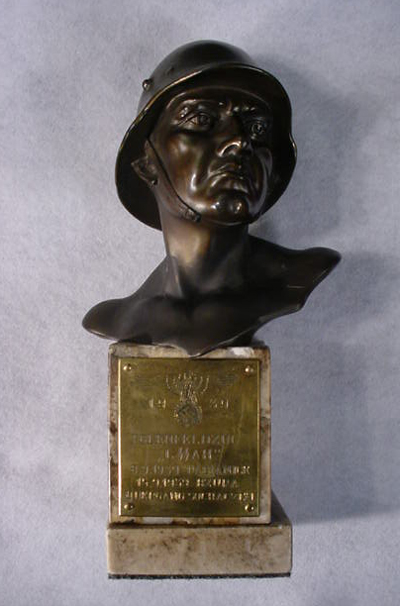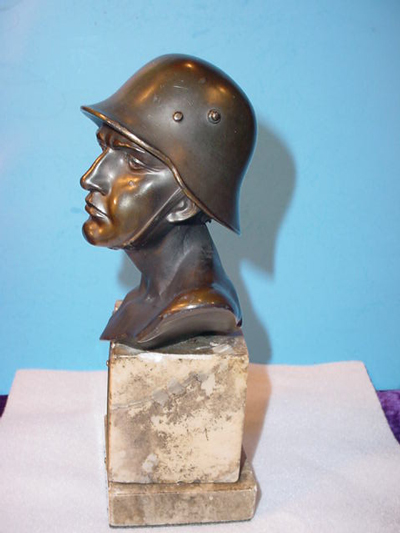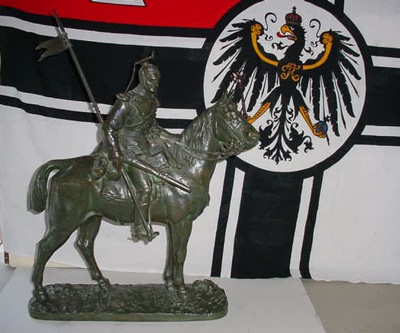
![]()

|
|
|
|
Important Sculptural Art
Page 2
|
||||||||
|
Hitler Bust by M. Ley (Item BRONZE 2-2; AH 20-1; ART 13-9) |
||||||||
| DESCRIPTION: This is one of the first bronze art pieces that we managed to purchase from stock that was maintained by a German company in Gleiwitz, on the outskirts of Berlin. The company name was “Bergwerks V. Hutten A6.” Go to Item ART 9-1 to see a narrative of how these fine sculptures were acquired. Hedwig Maria Ley was a woman sculptress, well known and accomplished in the period of the Third Reich. She enjoyed the sponsorship of Adolf Hilter himself after he saw a fine impression of Dietrich Eckhart, Hitler's friend and mentor. Her particular style is notable. The Hitler bust was said in party circles to be the best likeness of the Führer ever produced, even though Hitler favored the bust of himself by Ferdinand Lieberman. We know of this lady’s art and we realize she was among the best. In our extensive library we once had a picture of her sculpting the “Führerbuste.” If anyone has a good image and/or a biography of Frau Ley, we would appreciate it if they would help us out and educate us a bit further. The original bust we sold was in beautiful condition with only the plinth (base) replaced. Please read the narrative of how the Nuremberg eagles and standing Hitler statue were obtained. This bust measures 11 inches on the base. The bronze head by itself is about 7 inches high with a width ear to ear of 4 inches. The one we can procure today for you would be a perfect re-creation of the Maria Ley Hitler bust done in exactly the same manner as the original that we sold some time back. It would sell for the same price as the original and is 100 percent the quality.
PRICE: SOLD |

|

|
|
Heroic Bust of a German Soldier of the Great War (Item BRONZE 2-6; ART 17-5; AH 26-20; LEIBSS 1-3)
|
|
DESCRIPTION: Here is a beautiful bronze bust of a soldat of the First World War mounted on a marble two piece base with a plaque commemorating the campaign in Poland in 1939 and the participation of the elite SS Division SS Leibstandarte Adolf Hitler. It says: Polenfeldzug LSSAH, 8 9 1939 Pabiance, 15 9 1939 Bzura. Ubergand Sochaczew. These dates and places refer to battles in the Polish campaign Pabiance was captured by the SS Leibstandarte in Sept. 1939. The battle of Bzura was a battle in the opening campaign of WWII and fought between Polish and German forces. The SS LAH took a major part in the offensive. These battles were named as the Sochaczew area offensive. This would be basically the meaning of Ubergang Sochaczew. The statue with marble base is measured at 8 inches and the bronze soldatenkopf itself is about five inches tall. It is unsigned but a fine handsome likeness of what we call the ‘Geist des Deutschen Soldat” (the spirit of the German Soldier). The company of the SS LAH that added the plaque thought evidently that this would be the appropriate piece to honor their company and the Leibstandarte in general who paid the Poles back for Bronberg, Eichdorf, Hopfengarten, and Marzheim. Read about this on the web. The Polish attack against these innocent people was on orgy of murder and rape that is beyond belief. The testimony of 593 witnesses established the fact that at least 3841 named ethic Germans were murdered by the Poles prior to the German occupation. Is it any wonder that the Führer gave the order to invade Poland? Yes, there was payback (in spades) but the facts run contrary to the history that is promulgated by orthodox historians of today. Part of their agenda is to paint a picture of innocent little Poland being invaded by the nasty Nazis for no good reason. Revision is bringing history to square with the truth. PRICE: SOLD |

|

|
|
Bronze Wehrmacht and Party Eagle Desk Piece (Item BRONZE 2-7; ART 17-8; NSDAP 19-8) |
|
DESCRIPTION: Here is a magnificent sculpture in rich patinated bronze of the mighty German Hoheitsabzeichen or National Eagle. This configuration is different in that the eagle is perched upon a stationary swastika, not the usual mobile form. In the early days of the National Socialist movement this usage of the symbol was seen quite as much as the mobile form. This is one of the wonderful bronze sculptures that we managed to locate and purchase in the Gleiwitzdistrict near Berlin. See the Reichsparteitag Eagles at Partei 2-10. Here it explains how all the bronze sculptures came into our possession and this is one of the Prussian Bergwerk greats! The eagle on its double granite base is 9 ½ inches high. The actual bronze being 8 inches high. The wingspan is 6 inches. The depiction is spectacular embodying the mythos and spirit of the Third Reich like no other art object of the time. Strength, defiance, and majesty are apparent in the bold look of this magnificent sculpture. The base in granite was added later because the foundry had to order them separately in the 1930’s and 1940’s. We managed to find the marble quarry nearby that supplied the foundry in those days and we purchased plinths exactly like the originals that the eagles were mounted on. There might be a minor chip here and there (but certainly minor). These eagles were ordered by German army, navy, air force, and political-office groups as the ultimate desk ornament that portrayed national pride—and that it certainly does convey. No symbol of ultimate authority and nationalistic fervor ever existed that so graphically conveys such historical grandeur “Flieg Deutscher Adler, Flieg! (Fly German Eagle, Fly!)—from the NS song book . There is no artist’s signature on these eagles, but we suspect that they are by Herr Kurt Schmidt Ehmen the “Adlermeister” of the Third Reich. Also see the Eagle of the German Pavilion at Partei 2-11. We have only three of these; so don’t hesitate! PRICE: SOLD |
|
|||||||||||
Three-Dimensional Plaque in Iron of the Führer (Item BRONZE 2-8; ART 11-8; AH 17-1; BRONZEMET 2-12) |
|||||||||||
| DESCRIPTION: This is without any hesitation, incredible. It is an iron sculpture that could be called a plaque or a bust. Should we choose to call it a plaque it must be noted that it is completely 3-dimensional, standing out in amazing relief. You could also use the terminology, “one-quarter bust.” It measures 13 inches high and 7 3/4 inches across from ear to ear and 11 inches across the shoulders. The likeness is astounding and it depicts the Führer in the uniform shirt of the Kampfzeit (the struggle for power). The sculpture was accomplished in 1933 by an artist by the name of J. Ave. This was the Seigesjahr, or time of victory, for Hitler and the NSDAP. This is a heavy sculpture and the fittings on the back are structured to possibly be attached to a wooden plaque or possibly to an architectural wall, somewhere. We have been at this business for a very long time and have visited Kampfzeit collections in the U.S., Germany, the U.K., and Austria and we have never seen the likes of this one. We believe it is probably unique. On the backside it has the impressed wording: “Fr. Köster Heide” and something to the extent that copying it will be highly Verboten (forbidden). This also convinces us that this is a one-of-a-kind artistic endeavor. It is much rarer than any Hitler bust in bronze. This is an early treasure of the Third Reich that truly belongs in a museum or a notable collection.
PRICE: SOLD |
 |
 |
Massive Equestrian Bronze Statue of the 5th Regiment Prussian Uhlans (Item BRONZE 2-9; BRONZEMET 2-13; KHISTORY 1-15; KSTATUE 5-16) |
DESCRIPTION: This is a magnificent bronze depiction of a mounted horseman of the Fifth Uhlan Regiment of the Kaisers 3rd Cavalry Division attached to the First German Army Command. They served with particular distinction in the Franco Prussian war and WW1. Uhlans were light cavalry, actually Lancers, who fought with carbines, swords, and lances. The title Uhlan was used by Lancer regiments in the Russian, Austrian and especially the Prussian armies. Uhlans typically wore a double buttoned tunic (Kurta) with a colored panel at the front, a colored sash and a square topped Lancer cap (Czapka), also spelled chapka. This cap was originally derived from a traditional design of the Polish civilian cap made more formal and stylized for military use. Their Lances usually had small swallow tail pennants known as the Lance Pennon that was found just below the spearhead (see our pictures). Prussian Uhlans distinguished themselves and fought bravely in the war against Napoleon. In WW1 the Imperial German Army included 26 Uhlan regiments. They all saw action while on duty at the first part of the war and their charge with lances struck fear in the hearts of the enemy since it has well been known that these were formidable warriors adept at warfare (up front and personal!). Later in the second year of the war the Uhlan regiments were either dismounted to serve as cavalry rifle regiments in the trenches of the western front or transferred to the eastern front where primitive conditions made it still possible for horse cavalry to play an effective role. In WWII a popular myth is that Polish cavalry armed with lances charged and were annihilated by German tanks during the 1939 campaign; this arose from the misreporting (both intentional and unintentional) of the charge at Krojanty on 1 September when two squadrons of Polish 18th Lancers armed with lances and sabers were met in combat by German cavalry led by Harry Von Johnston in what was the last charge of German cavalry with sabre. The Poles were dispersed and defeated by Germans who rode one last time in the spirit of the Old Prussian Uhlans. This is a little known fact of history that for the most part has remained hidden for all these years. The bronze statue is accurate in every detail and prodigiously dramatic in its heroic depiction. It is a huge and heavy sculpture done in the finest mode of German bronze art. It measures 26 inches high from the bottom of the base to the top of the Uhlan Czapka. The horse is 22 inches long from tail to muzzle. The base is measured at 19 ½ x 7 inches. The sculpture is signed by Leon Mignon (1847-1898), a sculptor from Brussels, Belgium. He studied under the sculptor Prosper Drion (1822–1906) at the Académie in Liège from 1857 to 1871. He was a particular admirer of the anecdotal sculpture of Léopold Harzé (1831–1893). His vocation as a sculptor of animal subjects began in Rome, where he studied on a grant from 1872 to 1876. He exhibited in Ghent (1874) and on several occasions in Paris (where he lived from 1876 to 1882) at the Salon des Artistes Français. He achieved prominence at the exposition Universelle of 1878 in Paris with his bulls fighting in the Roman countryside (Brussels, mus. a. mod.). In 1880–81, he shared a studio with the Belgian sculptor Paul DeVigne, whom he had met in Rome. Mignon’s bull tamer (liège, parc avroy) took the gold medal at the Salon of 1880. In 1882 he settled in Brussels and in 1888 produced the labors of Hercules reliefs for the stairway of the palace of Charles de Lorraine (now part of the Bibliothèque Royale Albertier). He sculpted several historical figures for the provincial law courts and was an astute philosopher of his time. In 1892 he sculpted many subjects for the Université de Liège. He excelled as a sculptor of animal subjects. Mignon occupies a leading place in Belgian realist art. He also modeled busts of Belgian personalities as well as a statuette of the Belgian painter Hubert Bellis; figurines of workers, soldiers from the Belgian regiments (c. 1889), and even an equestrian statue of a Prussian Uhlan, France’s enemy in the 1870 war; and a statue of Leopold in 1886 ( Brussels, mus. a. mod.). His works are preserved in the Musée de l’art Wallon, Liège, and the Musée d’Art Moderne, Brussels. He was completing a frieze for the Hôtel Somzée in Brussels when he died unexpectedly. He was an amazing artist and a cultured man of vision. A grand museum grade art piece personified and extraordinaire! It is priced under market value for a sculpture as fine as this one is. It is certain that one could not find any such dramatic artistic accomplishment to rival this one. Here he is! In all his Imperial glory. Listen as you view him and perhaps, just perhaps, you will hear the strains of “Heil Dir im Seigerkranz” (Hail to thee in Victors Crown.) Deutschlands Helden Lebt in ewig leben! PRICE: SOLD |
Please refer to item designator in parentheses in all correspondence. Please E-mail for any additional information you may need.If you prefer, contact 'Germania' at PO Box 68, Lakemont, GA 30552 or call at 706.782.1668. Please! do not call during the wee hours of the morning. The best time for calling us is between 10 am and 12 noon and between 9 and 11 pm eastern time. |